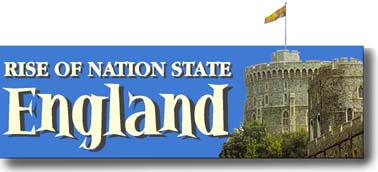|
|


Mr. Sedivy's
History Classes:









More Features:


 

 

|
|
Highlands Ranch High School - Mr. Sedivy
Highlands Ranch, Colorado
Rise of Nation State England
- Early English Life and Customs
-
Thanes, Churls and Thralls, Wergeld, Folk-Moot
Early English Life and Customs
Monks who kept historical records usually wrote only about kings and
churchmen. There are no pictures of them and little idea of what they
were like as people.

King Athelstan is portrayed presenting Bede's "Lives
of St. Cuthbert" to the saint himself on a visit in 934. This
is the earliest surviving presentation picture produced in England.
Beowulf
Beowulf was composed in England, probably some time in the eighth
century. Beowulf is a excellent source for information about life
during that time. Bede's history of the Christian kings of Northumbria
portrays them as peace loving, saintly men. This is probably a little
one-sided. From Beowulf, we get a more down-to-earth view of how kings
were surrounded by their warriors.
Thanes
The King's followers were known as "thanes." Thanes accompanied the
king when he rode out to hunt the stag - like bodyguards. Thanes helped
in war and helped keep law and order in the kingdom. A king's power
depended on the loyalty, strength and courage of his thanes.
The Danish king, Hrothgar, had a banqueting hall, which was a large
barn-like building made of wood. In return for their services, thanes
expected to be given weapons horses, food and drink, other gifts,
and the joys of the hall. The most valuable gift of all was land -
the real basis for wealth and power. Once they had an estate, they
could set up house and marry, but still always served the king. No
king was strong enough to gain control of the whole country until
the tenth century.
Churls and Thralls
The ordinary people in the English kingdoms farmed the land or worked
in village trade. Most were freemen called "churls," but there were
also "thralls" or slaves. Many thralls were from the unfortunate Britons.
Other thralls were prisoners taken in wars between the kingdoms, or
criminals unable to pay fines imposed on them. In very hard times,
when people were dying of starvation, parents might sell their children
into slavery.
Churls were mostly peasant farmers, owning a "hide" - a piece of
land large enough to support a household. The size of a hide varied
from place to place, but it was normally at lease 50 acres. They lived
in simple huts made of straw.
Wergeld
The chief mark distinguishing the ranks of the thane, churl, and thrall
was "wergeld." This was a man's "life-price" - the number of oxen
or the sum of money that had to be paid to his relatives by anyone
who killed him. Wergelds were fixed according to rank. In the laws
of King Ine of Wessex (688 - 726), a nobleman's life-price was six
times that of a churl. Fear of the victim's family helped to prevent
crime. (Today it's prison, police, etc.) Back then you could take
revenge on the person responsible or claim compensation based on the
wergeld.
Kings and Church leaders encouraged the peaceful method of settlement,
in money or goods. But if the wrongdoer would not, or could not pay
compensation, vengeance ("the blood feud") was the only alternative.
Some crimes, such as betrayal of one's lord, were so serious that
compensation was not enough. If the accused failed to appear to answer
the charges against him, he would be declared an outlaw and could
be killed by anyone.
The Folk-Moot
The people held "folk-moots," open-air meetings. The defendant would
swear a solemn oath of innocence and bring forward "oath helpers."
The value of oath helpers depended on their rank. If they could not
find enough oath helpers, they would use "trial by ordeal." A priest
took charge and chose either iron or water. It was believed that the
water would cast out the guilty, who floated, yet "receive" the innocent,
who sank!
The defendant carried a red-hot iron bar a short distance. The hand
was then bandaged. If the wound healed in there days without festering,
the defendant was declared innocent. God would give a judgment by
helping only the innocent.
Farming and Trade
Many of the English settlers took over lands cleared by the Britons.
The chief crops were barley, rye and wheat. Bees were kept. Honey
was important because in those days people had no sugar, so it was
the only kind of sweetening. Most villages had a "lord," one of the
king's thanes, whom the people looked to for protection. Besides giving
this free labor, they paid regular "food rent" in wheat, pigs, and
eggs.
Not all villagers farmed the land. Some carried on the necessary
trades. Smiths made tools and other implements, including ploughs,
shovels, pots and pans. There were also carpenters. Highly skilled
craftsmen such as goldsmiths, stone-masons and weapons-makers were
usually employed by kings.
They met most of their own essential needs. A few things were brought
in from outside such as iron and salt. It was very dangerous for peddlers
because there were outlaws in the woods.
King Ine's Law
"If a man from a distance or a foreigner
goes through the wood off track, and does not shout nor blow a horn,
he is be assumed a thief, to be either killed or redeemed."
They were forced to pay compensation across the Channel - mostly
for expensive luxuries such as wine, weapons, and glassware for kings
and nobles.
Back to top of page
Mr. Sedivy's Lecture Notes
& Historical Info
The Celts
| Gallic He-Men | Celtic
Culture, Trade, Religion, Women |
| Threat of the Celts - Celtic Battles and
Conquests |
- Rise of Nation State England -
| Roman Conquest of Britain | Christianity
in Britain |
| Customs: Thanes, Churls, Thralls, Wergeld,
Folk-Moot |
| Dark Ages: Alfred the Great, Edward the
Elder, Athelstan |
| The Return of the Vikings |
| Kings of Britain: Aethelred, Cnut, Edward
the Confessor |
| Bayeaux Tapestry, William the Conqueror,
Edward the Confessor, Harold Godwinson, Harold II |
| The Crusades: Richard Lion Heart, Pope
Urban |
| King John, Innocent III, Archbishop Stephen
Langton |
| Magna Carta / First Parliament |
Wales and Scotland
| Wales: Edward I, Llewellyn, Snowdonia
|
| Scotland: Alexander III, John Balliol,
William Wallace, Robert Bruce, King Edward II |
The 100 Years War
| Edward III, Longbows at Crecy, Edward IV,
Black Prince |
| Henry V, King Charles VI, Battle at Calais,
Treaty of Troyes |
More Information
| Other Kings of the Dark and Middle Ages:
William II, Henry I, Henry II |
| The
British Monarchy's Peerage: Dukes, Viscounts,
Marquess, Earls, Baronets, and Barons |
Class Activities
Roman Conquest Comparison
Battle of Agincourt
Related Information
Mr. Sedivy's World History - The Middle
Ages
The Complete Bayeux Tapestry
Roman Catholic Church in the Middle Ages
/ Crusades
The Hundred Years War
King Henry VIII
The Interesting
Life of Elizabeth I
The Stuarts - James I, Charles I, Charles
II, James II
Oliver Cromwell
|
|
|



![]() 9375 South Cresthill Lane
9375 South Cresthill Lane ![]() Highlands Ranch, Colorado 80126
Highlands Ranch, Colorado 80126 ![]() 303-471-7000
303-471-7000

